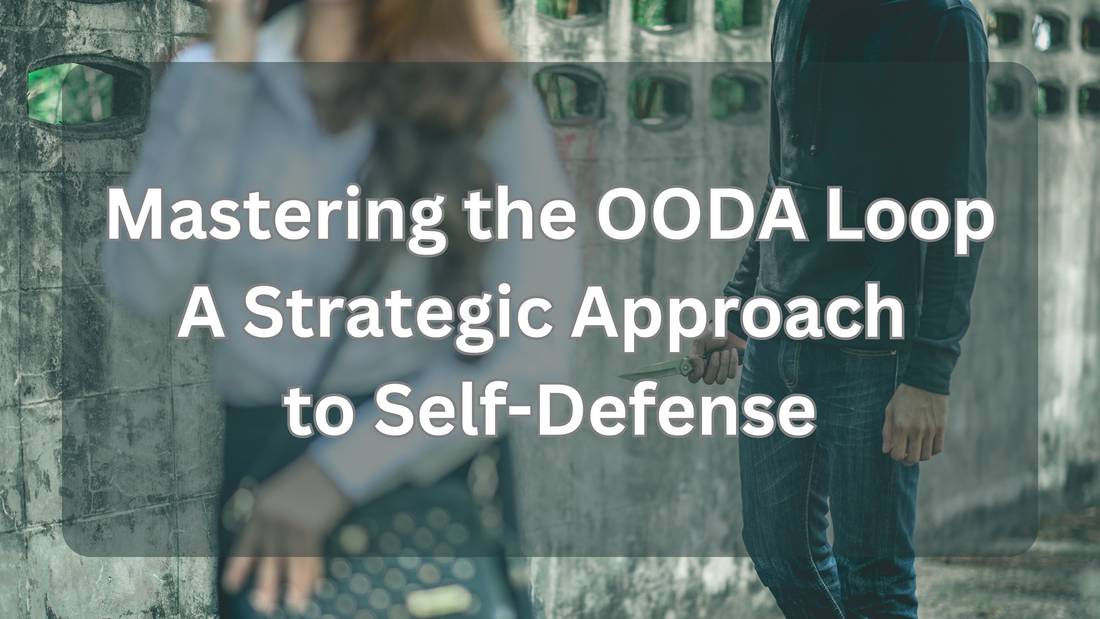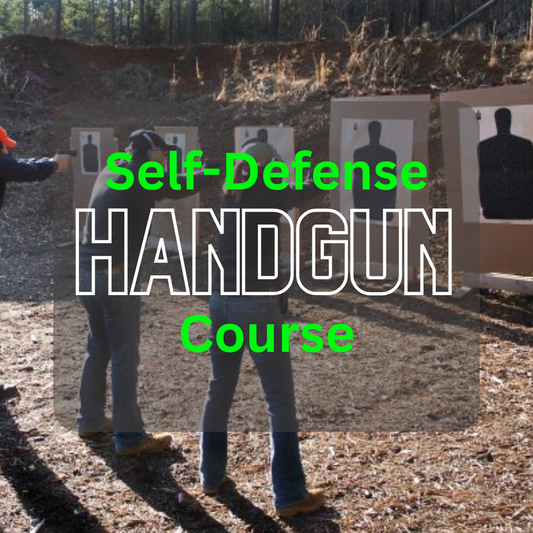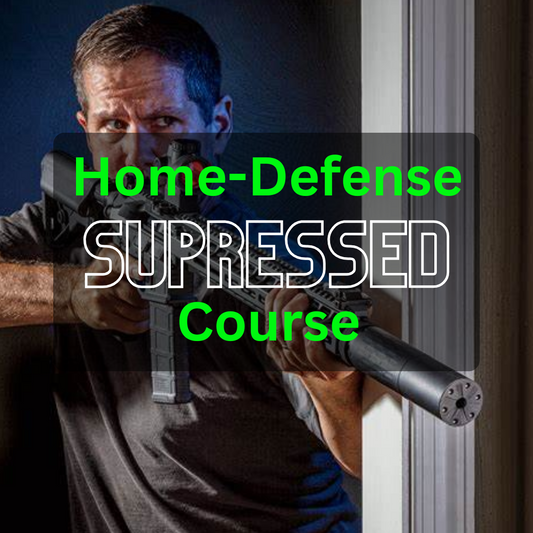
In the realm of self-defense, being able to react swiftly and effectively to potential threats is crucial. Enter Boyd's OODA Loop - a powerful decision-making process that has revolutionized strategic thinking and applications in various domains. Named after Colonel John Boyd, a United States Air Force fighter pilot, the OODA Loop enables individuals to think and act rapidly, gaining a decisive advantage over their opponents.
As you read through Boyd’s OODA Loop blog post, remember that this process facilitates rapid thought and action. You do not need to have all the answers before acting, as the OODA Loop involves incremental decision-making - decisions are made step by step and allow for adjustments based on feedback and results. The brilliance of the OODA Loop lies in its four steps: Observe, Orient, Decide, Act. These four steps correspond to the way that humans react to a situation.
In this blog post, we will explore Boyd's OODA Loop in the context of self-defense. We will delve into its four essential steps: Observe, Orient, Decide, and Act, and discuss how these steps mirror the natural reaction process of humans in high-pressure situations. By harnessing the power of the OODA Loop, you too can enhance your ability to make quick, informed decisions and outmaneuver potential threats.
Let's begin the journey of mastering the OODA Loop and unlocking its potential in the realm of self-defense.
Observation:
In the realm of self-defense, the first critical step within Boyd's OODA loop is to observe. This phase involves sharpening your situational awareness to a keen edge, enabling you to perceive your surroundings with heightened clarity.
Situational Awareness: Situational awareness is the foundation of effective self-defense. It entails being fully present in the moment, attuned to your environment, and conscious of potential dangers. By maintaining a heightened state of awareness, you empower yourself to detect subtle cues and anomalies that might signify a threat.
Recognizing Potential Threats: During the observe phase, it's essential to develop the ability to recognize potential threats swiftly. This goes beyond merely acknowledging the obvious; it involves discerning subtle indicators that might precede an imminent danger. Understanding the difference between normal and abnormal behavior can be a key factor in identifying potential threats.
Gathering Relevant Information: Accurate information is a potent tool in self-defense. In the observe phase, gather relevant details about your surroundings, such as escape routes, nearby exits, and potential obstacles. Additionally, assess the individuals in your vicinity and their demeanor, as this information will be crucial in later stages of the OODA loop.
By honing your observational skills in these aspects, you lay the groundwork for a proactive and informed approach to self-defense, setting the stage for the subsequent stages of Boyd's OODA loop.

Orient
Moving beyond observation, the second phase of Boyd's OODA loop is orient, a crucial step in self-defense that involves gaining a deep understanding of your surroundings and your own capabilities.
Analyzing the Situation: Once you've observed the environment and potential threats, the orient phase prompts you to analyze the situation comprehensively. This involves interpreting the gathered information, assessing the context, and forming a clear mental picture of the unfolding events. By doing so, you enhance your ability to make informed decisions in the subsequent stages.
Understanding Surroundings and Variables: Orienting yourself also means grasping the intricacies of your surroundings and the variables at play. Consider factors such as lighting conditions, terrain, and any potential obstacles that might affect your movements. Understanding these elements enables you to adapt your strategies accordingly and navigate the environment effectively.
Evaluating Personal Capabilities and Limitations: Self-awareness is a fundamental aspect of effective self-defense. During the orient phase, take a candid look at your own capabilities and limitations. Understand your physical abilities, knowledge of self-defense techniques, and any tools or resources at your disposal. Realistic self-assessment lays the foundation for making decisions that align with your strengths while acknowledging potential vulnerabilities.
By actively engaging in the orient phase, you position yourself to respond more effectively in self-defense scenarios. This stage equips you with a comprehensive understanding of the situation, enabling you to make decisions that are both adaptive and strategically sound.
Decide
As you progress through Boyd's OODA loop in the context of self-defense, the third pivotal stage is "Decide." This phase involves thoughtful decision-making and strategic planning to navigate the imminent threat.
Formulating a Response Strategy: In the decide phase, your focus shifts to formulating a response strategy tailored to the observed and analyzed information. This includes selecting appropriate self-defense techniques, deciding on evasion or confrontation, and considering potential escape routes. Crafting a well-thought-out response strategy lays the groundwork for effective execution in the next stage.
Prioritizing Actions Based on Threat Level: Understanding the severity of the threat is paramount in self-defense decision-making. Prioritize actions based on the perceived threat level. This involves assessing whether de-escalation, verbal communication, or physical intervention is most appropriate. By prioritizing actions, you optimize your chances of diffusing the situation while minimizing risk.
Considering Ethical and Legal Aspects: Decisions in self-defense must be grounded in a clear understanding of ethical and legal considerations. While formulating your response strategy, evaluate the moral implications of your actions and ensure they align with legal boundaries. This involves discerning when the use of force is justifiable and being mindful of potential consequences.
In the decide phase, your ability to make swift and well-informed decisions becomes a crucial factor in self-defense. By carefully weighing options, prioritizing actions, and adhering to ethical and legal standards, you pave the way for a more controlled and responsible response to potential threats.

Act
As the OODA loop progresses to the "Act" phase in the realm of self-defense, the emphasis shifts from decision-making to the execution of a chosen course of action.
Implementing Chosen Course of Action: Having formulated a response strategy and prioritized actions, it's time to implement your chosen course of action. This involves putting your decision into motion, whether it's deploying a specific self-defense technique, initiating a verbal de-escalation, or executing a planned escape. The effectiveness of your chosen course of action relies on the seamless transition from decision to implementation.
Executing Techniques for Self-Defense: In the act phase, physical or verbal techniques are employed to protect oneself. This might include martial arts moves, defensive maneuvers, or assertive communication skills. Precision and speed are key as you work to neutralize the threat or create a safe distance. The execution of well-practiced self-defense techniques enhances your ability to respond effectively under pressure.
Adaptive Decision-Making During the Confrontation: Adaptability is a critical aspect of the act phase. Confrontations are dynamic, and circumstances may change rapidly. Adaptive decision-making involves remaining alert to shifts in the situation, adjusting your tactics accordingly, and being prepared to modify your course of action as needed. This flexibility is essential for maintaining control and responding effectively to evolving threats.
In the act phase, the culmination of observation, orientation, and decision-making comes to fruition through active engagement. Successfully implementing your chosen course of action, executing practiced techniques, and adapting in real-time contribute to a comprehensive and dynamic approach to self-defense.
Looping
Entering the "Looping" phase in Boyd's OODA loop for self-defense underscores the importance of continual refinement and adaptability.
Emphasizing the Iterative Nature of the OODA Loop: Central to the OODA loop is its iterative nature. Emphasize the importance of recognizing that the process is not linear; rather, it's a continuous loop. Acknowledge that self-defense is a dynamic situation that requires constant reassessment. Reinforce the idea that each completion of the loop refines your understanding and enhances your ability to respond effectively.
Continuously Updating Observations and Decisions: In the looping phase, stress the need for ongoing observation and decision updates. Encourage individuals to stay vigilant, reassess the environment, and remain attuned to potential changes. By continuously updating observations and decisions, you ensure that your response remains relevant and aligned with the evolving dynamics of the situation.

Staying Ahead of the Threat Through Rapid Cycling: Remaining ahead of potential threats is a key objective in self-defense. Highlight the concept of rapid cycling within the OODA loop – the ability to move through the stages swiftly and seamlessly. This agility enables individuals to stay proactive, anticipate changes, and respond decisively. Rapid cycling empowers you to maintain control and outmaneuver potential threats effectively.
In the looping phase, the OODA loop transforms from a sequence of steps into a dynamic, fluid process. By embracing the iterative nature, continuously updating observations and decisions, and staying ahead of threats through rapid cycling, individuals enhance their overall effectiveness in self-defense scenarios.So, let us embark on the journey of mastering the OODA Loop and unlocking its potential in the realm of self-defense. By practicing and applying this strategic approach, you will gain the skills and mindset needed to navigate high-pressure situations with confidence and control. Stay alert, stay focused, and stay one step ahead. Your safety and security depend on it.
John Boyette






